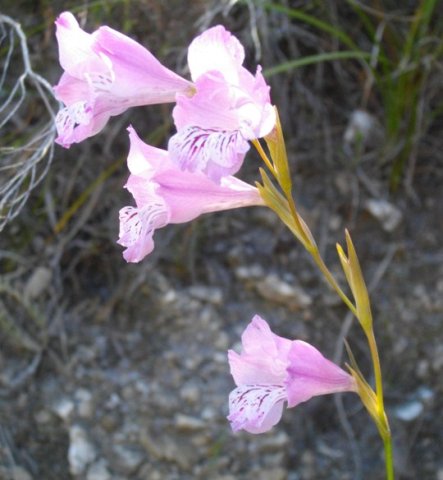Gladiolus hirsutus

Author: Ivan Lätti
Photographer: Thabo Maphisa
Gladiolus hirsutus, commonly known as the lapmuis (cloth mouse) in Afrikaans and previously scientifically as G. tristis var. purpureus, is a cormous perennial reaching heights from 35 cm to 50 cm. The globose corm, covered in coarse, vertical fibre tunics are from 2 cm to 4 cm in diameter.
Apart from the normal leaves there are some small, membranous cataphylls at the base, dry or hairy and pale green to purple. Four or five annual, sword-shaped leaves are grown, some basal in a loose fan and one or two up the stem. The leaves are fairly short with thickened margins and midribs. The blades are hairy, particularly on the sheaths. The specific name, hirsutus, is a Latin word meaning shaggy or bristly, referring to the leaf hairiness. The narrow leaves are from 10 mm to 27 mm wide.
The flower spike is erect, bearing from two to eight pink, white or purple flowers. The flowers of G. hirsutus have short tubes about 2 cm long, the corollas two-lipped with irregular dark red or purple streaks on the lower three tepals. The common name of lapmuis may refer to the shape of the corolla. The blooming season is winter to after midspring. Flowering is best after veld fires. The flowers are probably pollinated by long-tongued bees
The species distribution is in the west of the Western Cape, from the Cape Peninsula to the Koue Bokkeveld in the north and along the Langeberg Mountains to the Robinson Pass in the east.
The habitat is fynbos on granite and sandstone slopes. The habitat population is deemed of least concern early in the twenty first century (Bean and Johns, 2005; Goldblatt and Manning, 1998; www.fernkloof.com; www.pacificbulbsociety.org; http://redlist.sanbi.org).

